中国传统建筑力与美英文
- 格式:pptx
- 大小:9.66 MB
- 文档页数:69
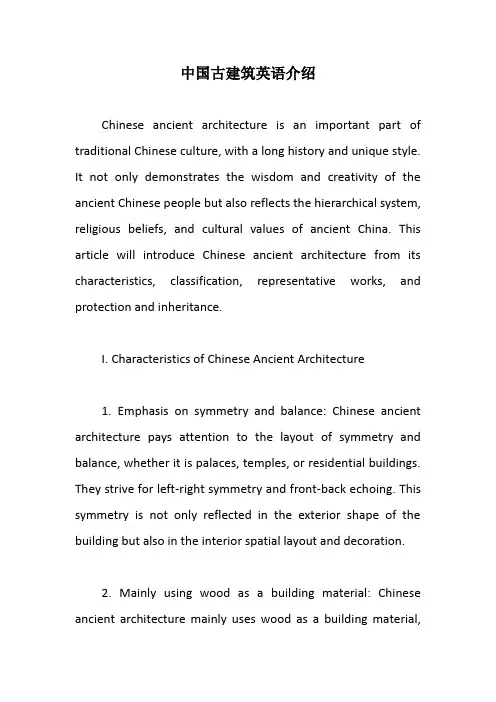
中国古建筑英语介绍Chinese ancient architecture is an important part of traditional Chinese culture, with a long history and unique style. It not only demonstrates the wisdom and creativity of the ancient Chinese people but also reflects the hierarchical system, religious beliefs, and cultural values of ancient China. This article will introduce Chinese ancient architecture from its characteristics, classification, representative works, and protection and inheritance.I. Characteristics of Chinese Ancient Architecture1. Emphasis on symmetry and balance: Chinese ancient architecture pays attention to the layout of symmetry and balance, whether it is palaces, temples, or residential buildings. They strive for left-right symmetry and front-back echoing. This symmetry is not only reflected in the exterior shape of the building but also in the interior spatial layout and decoration.2. Mainly using wood as a building material: Chinese ancient architecture mainly uses wood as a building material,such as beams, columns, purlins, and brackets. Wood has good plasticity and toughness, is easy to process and install, and also has good thermal insulation performance.3. Rich and diverse roof shapes: The roof shapes of Chinese ancient architecture are rich and diverse, such as hip roof, gable roof, suspended roof, and winged roof. These roof shapes not only have practicality but also strong decorative features, reflecting the aesthetic concept of ancient Chinese architecture.4. Carving and painting art: The carving and painting art of Chinese ancient architecture is rich and colorful, such as woodcarving, brick carving, stone carving, and murals. These carved and painted works are both decorative and symbolic, reflecting information about ancient Chinese society's politics, economy, culture, etc.5. Color application: The color application of Chinese ancient architecture emphasizes harmony and contrast, mainly using red, yellow, green, blue, etc. as the main color scheme. Red represents joy, auspiciousness, yellow represents royalauthority, green represents life and hope, blue represents the sky and the sea. The use of these colors not only reflects the aesthetic concept of ancient Chinese architecture but also reflects the cultural values of ancient society.II. Classification of Chinese Ancient Architecture1. Palace architecture: Palace architecture is the place where ancient Chinese emperors lived and handled political affairs, such as the Forbidden City in Beijing and the Shenyang Imperial Palace. These palace buildings are large in scale, majestic in momentum, and have high historical, artistic, and scientific value.2. Temple architecture: Temple architecture is the place where ancient Chinese people worshipped gods and ancestors, such as Tai Mountain Dai Temple and Songshan Shaolin Temple. These temple buildings usually have a solemn and respectful atmosphere, reflecting the ancient people's awe towards gods and ancestors.3. Garden architecture: Garden architecture is the placewhere ancient Chinese people leisured, visited, and enjoyed natural landscapes, such as Suzhou Humble Administrator's Garden and Hangzhou West Lake. These garden buildings focus on creating landscapes of mountains and rivers, emphasizing the harmonious coexistence between humans and nature.4. Residential architecture: Residential architecture is the place where ancient Chinese common people lived, such as Beijing Siheyuan and Shanxi Pingyao Ancient City. These residential buildings have distinct regional characteristics and ethnic styles, reflecting the living habits and cultural traditions of ancient people.5. Religious architecture: Religious architecture is the place where various religious beliefs in ancient China were practiced, such as Buddhist temples and Taoist palaces. These religious buildings usually have high artistic value, such as the Mogao Grottoes in Dunhuang and Longmen Grottoes.III. Representative Works of Chinese Ancient Architecture1. The Forbidden City: Located in the center of Beijing, it isthe imperial palace of Ming and Qing Dynasties in China and also the largest existing wooden structure ancient architectural complex in the world. The Forbidden City is famous for its grand architectural scale, exquisite carving art, and rich collection of cultural relics.2. The Great Wall: Located on the northern border of China, it is a military defense project built by ancient China to defend against northern nomadic invasions. The Great Wall is about 23,000 kilometers long, making it the longest wall in the world and known as the "Ten Thousand Li Great Wall."。

弘扬中国优秀传统建筑的英语作文English:Ancient Chinese architecture has been a pinnacle of excellence and elegance throughout history, showcasing intricate craftsmanship and cultural significance. From the majestic Forbidden City in Beijing to the serene gardens of Suzhou, traditional Chinese architecture embodies harmony with nature and striking beauty in design. The use of timber, ceramic tiles, and intricate carvings in structures such as pagodas and courtyard houses reflect a deep respect for tradition and a connection to the spiritual world. These architectural wonders not only serve as a testament to the skill and creativity of ancient builders but also serve as a reminder of the rich history and culture of China. It is essential to promote and preserve these architectural treasures to ensure that future generations can continue to appreciate and learn from the ingenuity and artistry of traditional Chinese architecture.中文翻译:古代中国建筑在历史上一直是卓越和优美的典范,展示了复杂的工艺和文化意义。
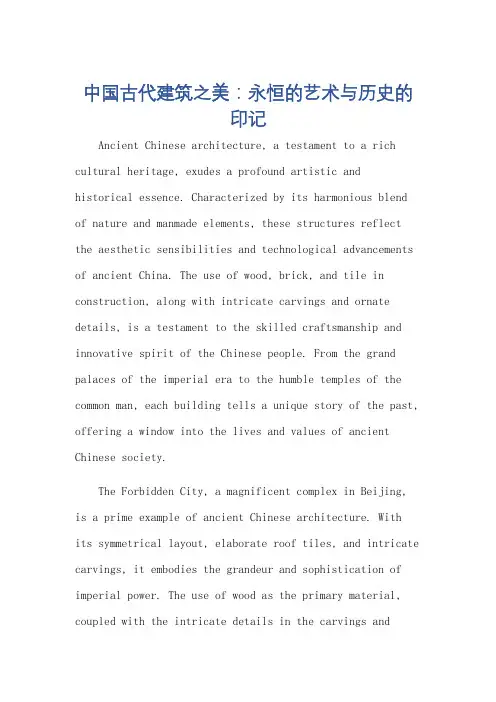
中国古代建筑之美:永恒的艺术与历史的印记Ancient Chinese architecture, a testament to a rich cultural heritage, exudes a profound artistic andhistorical essence. Characterized by its harmonious blend of nature and manmade elements, these structures reflect the aesthetic sensibilities and technological advancements of ancient China. The use of wood, brick, and tile in construction, along with intricate carvings and ornate details, is a testament to the skilled craftsmanship and innovative spirit of the Chinese people. From the grand palaces of the imperial era to the humble temples of the common man, each building tells a unique story of the past, offering a window into the lives and values of ancient Chinese society.The Forbidden City, a magnificent complex in Beijing, is a prime example of ancient Chinese architecture. Withits symmetrical layout, elaborate roof tiles, and intricate carvings, it embodies the grandeur and sophistication of imperial power. The use of wood as the primary material, coupled with the intricate details in the carvings andpaintings, showcases the skilled craftsmanship of the Chinese artisans. Similarly, the Great Wall, a testament to ancient Chinese military might, is a remarkable feat of engineering, built using millions of bricks and stones, each carefully fitted into place.Moreover, temples and pagodas throughout China exhibit the religious and cultural diversity of the country. The Temple of Heaven in Beijing, dedicated to the worship of heaven and earth, features a circular design symbolizing infinity and perfection. The pagodas, such as the Leifeng Pagoda in Hangzhou, are elegant towers with multi-story designs, often adorned with beautiful carvings and paintings. These structures not only serve as places of worship but also as beautiful landmarks that enhance the aesthetic value of the surrounding landscapes.The influence of Confucianism is also evident in the layout and design of ancient Chinese buildings. The emphasis on harmony and balance is reflected in the symmetrical designs and the use of natural elements such as wood and stone. This philosophy is further emphasized inthe use of open courtyards and gardens, which provide a sense of tranquility and connectivity with nature.In conclusion, ancient Chinese architecture is a rich tapestry of cultural, historical, and artistic values. It embodies the spirit of the Chinese people, their aesthetic sensibilities, technological advancements, and deep-rooted cultural beliefs. These structures, whether grand palacesor humble temples, continue to inspire andamaze us withtheir timeless beauty and profound historical significance. **中国古代建筑之美:永恒的艺术与历史的印记**中国古代建筑,作为丰富文化遗产的见证,散发出深厚的艺术和历史底蕴。
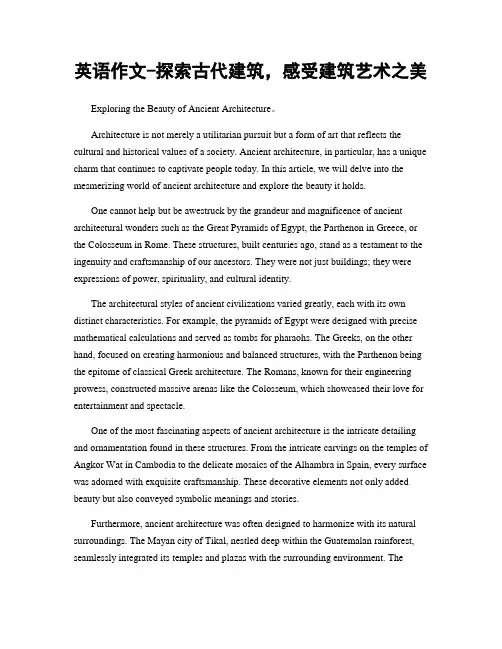
英语作文-探索古代建筑,感受建筑艺术之美Exploring the Beauty of Ancient Architecture。
Architecture is not merely a utilitarian pursuit but a form of art that reflects the cultural and historical values of a society. Ancient architecture, in particular, has a unique charm that continues to captivate people today. In this article, we will delve into the mesmerizing world of ancient architecture and explore the beauty it holds.One cannot help but be awestruck by the grandeur and magnificence of ancient architectural wonders such as the Great Pyramids of Egypt, the Parthenon in Greece, or the Colosseum in Rome. These structures, built centuries ago, stand as a testament to the ingenuity and craftsmanship of our ancestors. They were not just buildings; they were expressions of power, spirituality, and cultural identity.The architectural styles of ancient civilizations varied greatly, each with its own distinct characteristics. For example, the pyramids of Egypt were designed with precise mathematical calculations and served as tombs for pharaohs. The Greeks, on the other hand, focused on creating harmonious and balanced structures, with the Parthenon being the epitome of classical Greek architecture. The Romans, known for their engineering prowess, constructed massive arenas like the Colosseum, which showcased their love for entertainment and spectacle.One of the most fascinating aspects of ancient architecture is the intricate detailing and ornamentation found in these structures. From the intricate carvings on the temples of Angkor Wat in Cambodia to the delicate mosaics of the Alhambra in Spain, every surface was adorned with exquisite craftsmanship. These decorative elements not only added beauty but also conveyed symbolic meanings and stories.Furthermore, ancient architecture was often designed to harmonize with its natural surroundings. The Mayan city of Tikal, nestled deep within the Guatemalan rainforest, seamlessly integrated its temples and plazas with the surrounding environment. Theancient city of Petra in Jordan, carved into the rose-colored cliffs, is another remarkable example of how architecture can blend harmoniously with nature.Beyond their aesthetic appeal, ancient architectural wonders also provide valuable insights into the history and culture of civilizations long gone. They offer a glimpse into the lives of ancient societies, their beliefs, and their way of life. By studying these architectural marvels, archaeologists and historians can piece together the puzzle of our past and gain a deeper understanding of our collective heritage.In conclusion, ancient architecture is a testament to the creativity, skill, and vision of our ancestors. These magnificent structures not only showcase the architectural achievements of their time but also serve as a bridge between the past and the present. By exploring and appreciating the beauty of ancient architecture, we can gain a deeper appreciation for the rich tapestry of human history and the enduring power of human creativity.。
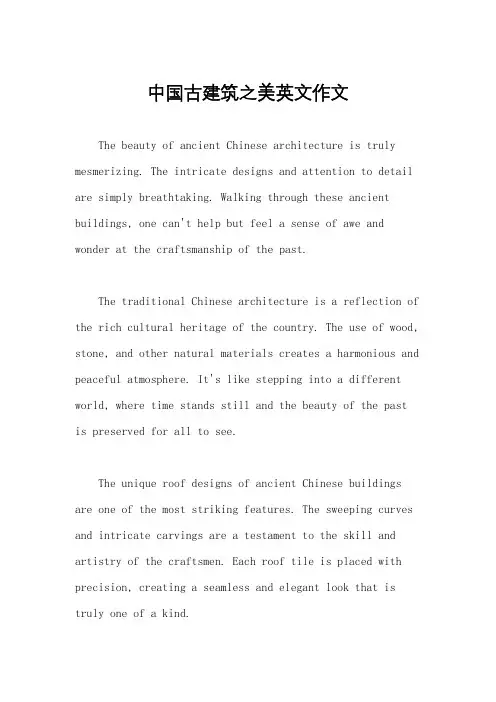
中国古建筑之美英文作文The beauty of ancient Chinese architecture is truly mesmerizing. The intricate designs and attention to detail are simply breathtaking. Walking through these ancient buildings, one can't help but feel a sense of awe and wonder at the craftsmanship of the past.The traditional Chinese architecture is a reflection of the rich cultural heritage of the country. The use of wood, stone, and other natural materials creates a harmonious and peaceful atmosphere. It's like stepping into a different world, where time stands still and the beauty of the past is preserved for all to see.The unique roof designs of ancient Chinese buildings are one of the most striking features. The sweeping curves and intricate carvings are a testament to the skill and artistry of the craftsmen. Each roof tile is placed with precision, creating a seamless and elegant look that is truly one of a kind.The use of symbolism in ancient Chinese architecture is also fascinating. From the placement of certain elements to the use of colors and patterns, every detail has a deeper meaning. It's like a language of its own, telling stories and conveying beliefs through the design of the buildings.The sense of harmony and balance in ancient Chinese architecture is truly remarkable. The careful placement of buildings, courtyards, and gardens creates a sense of tranquility and peace. It's a reminder of the importance of living in harmony with nature and the world around us.In conclusion, the beauty of ancient Chinese architecture is something that must be experienced firsthand. It's a journey through time and culture, a glimpse into the rich history and traditions of the Chinese people. The intricate designs, symbolism, and sense of harmony all come together to create something truly extraordinary.。
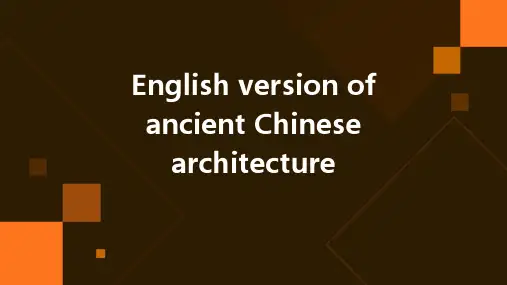
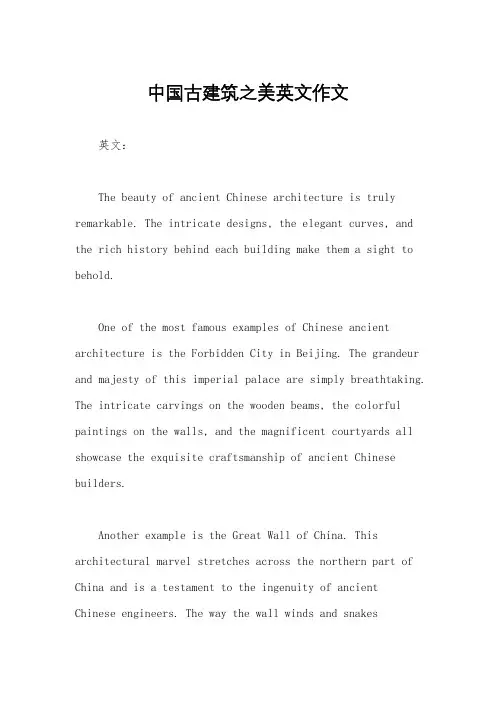
中国古建筑之美英文作文英文:The beauty of ancient Chinese architecture is truly remarkable. The intricate designs, the elegant curves, and the rich history behind each building make them a sight to behold.One of the most famous examples of Chinese ancient architecture is the Forbidden City in Beijing. The grandeur and majesty of this imperial palace are simply breathtaking. The intricate carvings on the wooden beams, the colorful paintings on the walls, and the magnificent courtyards all showcase the exquisite craftsmanship of ancient Chinese builders.Another example is the Great Wall of China. This architectural marvel stretches across the northern part of China and is a testament to the ingenuity of ancient Chinese engineers. The way the wall winds and snakesthrough the rugged terrain is a feat of engineering thatstill astounds visitors today.In addition to these famous landmarks, there are countless traditional Chinese houses, temples, and gardens that also showcase the beauty of ancient Chinese architecture. The elegant curved roofs, the intricatelattice windows, and the serene courtyards all reflect the harmony and balance that are central to Chinesearchitectural principles.The use of traditional materials such as wood, stone, and clay, as well as the incorporation of natural elements like water and plants, further enhance the beauty ofancient Chinese architecture. The attention to detail and the emphasis on harmony with nature make these buildingsnot only aesthetically pleasing but also deeply meaningful.中文:中国古建筑之美确实令人叹为观止。
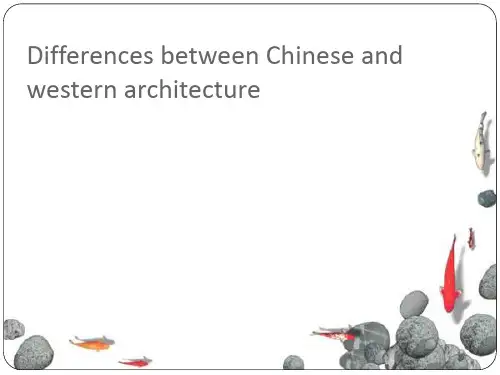
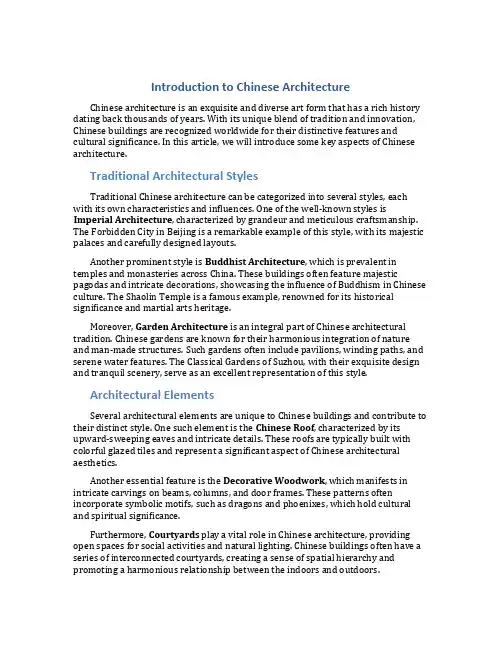
Introduction to Chinese ArchitectureChinese architecture is an exquisite and diverse art form that has a rich history dating back thousands of years. With its unique blend of tradition and innovation, Chinese buildings are recognized worldwide for their distinctive features and cultural significance. In this article, we will introduce some key aspects of Chinese architecture.Traditional Architectural StylesTraditional Chinese architecture can be categorized into several styles, each with its own characteristics and influences. One of the well-known styles is Imperial Architecture, characterized by grandeur and meticulous craftsmanship. The Forbidden City in Beijing is a remarkable example of this style, with its majestic palaces and carefully designed layouts.Another prominent style is Buddhist Architecture, which is prevalent in temples and monasteries across China. These buildings often feature majestic pagodas and intricate decorations, showcasing the influence of Buddhism in Chinese culture. The Shaolin Temple is a famous example, renowned for its historical significance and martial arts heritage.Moreover, Garden Architecture is an integral part of Chinese architectural tradition. Chinese gardens are known for their harmonious integration of nature and man-made structures. Such gardens often include pavilions, winding paths, and serene water features. The Classical Gardens of Suzhou, with their exquisite design and tranquil scenery, serve as an excellent representation of this style.Architectural ElementsSeveral architectural elements are unique to Chinese buildings and contribute to their distinct style. One such element is the Chinese Roof, characterized by its upward-sweeping eaves and intricate details. These roofs are typically built with colorful glazed tiles and represent a significant aspect of Chinese architectural aesthetics.Another essential feature is the Decorative Woodwork, which manifests in intricate carvings on beams, columns, and door frames. These patterns often incorporate symbolic motifs, such as dragons and phoenixes, which hold cultural and spiritual significance.Furthermore, Courtyards play a vital role in Chinese architecture, providing open spaces for social activities and natural lighting. Chinese buildings often have a series of interconnected courtyards, creating a sense of spatial hierarchy and promoting a harmonious relationship between the indoors and outdoors.Feng Shui and Cultural SignificanceIn Chinese architecture, the concept of Feng Shui holds great importance. Feng Shui is the practice of arranging buildings and spaces harmoniously to promote balance and harmony. It takes into account factors such as orientation, layout, and the flow of energy. Following Feng Shui principles ensures a fruitful and prosperous living environment.Chinese architecture also reflects the country’s rich cultural heritage and philosophical beliefs. The emphasis on harmony and balance stems from the ancient philosophy of Confucianism, which greatly influenced Chinese society and its architectural traditions.Contemporary DevelopmentsWhile preserving its traditional roots, Chinese architecture has also embraced modern influences and innovative designs in recent years. Many cities in China exhibit awe-inspiring skyscrapers, futuristic structures, and avant-garde designs. The B ird’s Nest stadium in Beijing, designed for the 2008 Olympic Games, is an iconic example of contemporary Chinese architecture.ConclusionChinese architecture is an extraordinary blend of artistic expression, cultural symbolism, and functional design. Its rich history, traditional styles, and distinctive elements make it a fascinating subject of study. From ancient temples to modern skyscrapers, Chinese architecture continues to captivate and inspire individuals worldwide.。
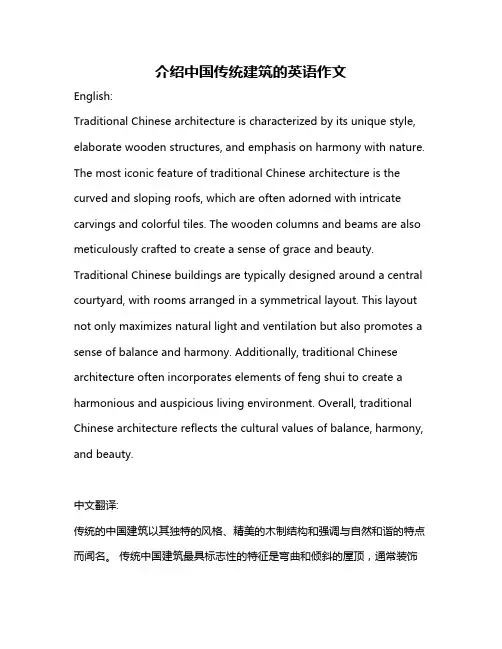
介绍中国传统建筑的英语作文English:Traditional Chinese architecture is characterized by its unique style, elaborate wooden structures, and emphasis on harmony with nature. The most iconic feature of traditional Chinese architecture is the curved and sloping roofs, which are often adorned with intricate carvings and colorful tiles. The wooden columns and beams are also meticulously crafted to create a sense of grace and beauty. Traditional Chinese buildings are typically designed around a central courtyard, with rooms arranged in a symmetrical layout. This layout not only maximizes natural light and ventilation but also promotes a sense of balance and harmony. Additionally, traditional Chinese architecture often incorporates elements of feng shui to create a harmonious and auspicious living environment. Overall, traditional Chinese architecture reflects the cultural values of balance, harmony, and beauty.中文翻译:传统的中国建筑以其独特的风格、精美的木制结构和强调与自然和谐的特点而闻名。
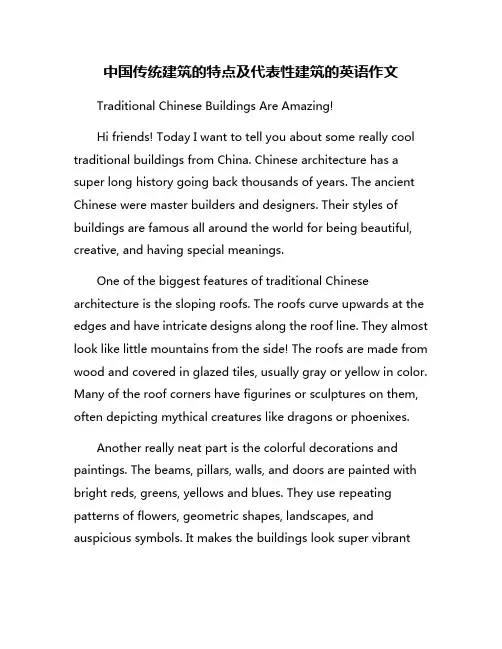
中国传统建筑的特点及代表性建筑的英语作文Traditional Chinese Buildings Are Amazing!Hi friends! Today I want to tell you about some really cool traditional buildings from China. Chinese architecture has a super long history going back thousands of years. The ancient Chinese were master builders and designers. Their styles of buildings are famous all around the world for being beautiful, creative, and having special meanings.One of the biggest features of traditional Chinese architecture is the sloping roofs. The roofs curve upwards at the edges and have intricate designs along the roof line. They almost look like little mountains from the side! The roofs are made from wood and covered in glazed tiles, usually gray or yellow in color. Many of the roof corners have figurines or sculptures on them, often depicting mythical creatures like dragons or phoenixes.Another really neat part is the colorful decorations and paintings. The beams, pillars, walls, and doors are painted with bright reds, greens, yellows and blues. They use repeating patterns of flowers, geometric shapes, landscapes, and auspicious symbols. It makes the buildings look super vibrantand lively! There are also many carvings in the wood and stone with dragons, phoenixes, qilins and other legendary animals.The floor plans of Chinese buildings are usually arranged around rectangular courtyards. The rooms, hallways, and buildings are all positioned symmetrically facing the courtyards. Having courtyards allows plenty of natural light and airflow inside. The layouts create a sense of balance and harmony.Many traditional buildings use certain numbers that were considered lucky or significant. For example, there are often 9 ridges on the roofs because 9 was regarded as the highest single digit number. Or there might be sets of 3 rooms or architectural elements, since 3 is a lucky number. The numbers give meaning and symbolism.Now let me tell you about some famous traditional Chinese buildings that show off these awesome features! One of the most iconic is the Forbidden City in Beijing. It was the grand palace for 24 emperors during the Ming and Qing dynasties from the 1400s to the 1900s. The Forbidden City has nearly 1000 buildings with 9,999 rooms! It's absolutely massive.The whole complex is laid out precisely facing south in perfect symmetry. The most important throne and ceremony halls are in the center, with lesser buildings surrounding them.The roofs have those curving eaves with bright yellow glazed tiles. Literally every inch is decorated with intricate carvings of dragons, clouds, and other symbols. It's like an entire city of palaces!Another breathtaking example is the Temple of Heaven in Beijing. This collection of religious buildings was where emperors would go to pray for good harvests and make offerings to heaven. The highlight is the amazing triple-gabled circular temple called the Imperial Vault of Heaven. It has three tiers of roofs stacked on top of each other, all elaborately decorated. The marble altar in the center is intricately carved with swirling designs.In Suzhou, there are incredible Chinese gardens like the Humble Administrator's Garden and the Master of Nets Garden. They have beautiful pavilions, bridges, rockeries, and ponds winding through scenic landscapes. Every view is like a living painting with flowering trees, rock sculptures, and bubbling streams. The architectural styles make you feel at peace while wandering through.The Leshan Giant Buddha near Chengdu is one of the tallest Buddha statues ever built. This massive 233-foot stone sculpture depicts Buddha sitting serenely. It was carved into the side of amountain cliff starting way back in the 700s! The details of Buddha's robes and facial features are incredibly precise. It lets you imagine what it was like for the ancient sculptors to create such an enormous work of art.Those are just a few highlights of China's marvelous traditional architecture. No matter if it's towering imperial palaces, tranquil gardens, or massive sculptures, the craftsmanship and artistry are simply jaw-dropping. The distinctive roofs, artwork, layouts, symbolism and colors make them unmistakably Chinese. I feel so lucky to learn about these magnificent buildings that were created centuries ago. China is home to some of humanity's most outstanding architectural and artistic achievements!。
弘扬中国优秀传统建筑的英语作文In the vast and diverse cultural landscape of China, traditional architecture stands as a towering testament to the nation's rich historical and artistic heritage. Spanning across multiple eras and regions, these structures are not just物理 spaces but also repositories of cultural values, artistic expressions, and technological innovations. The beauty and elegance of Chinese traditional architecture are not confined to a single style or material but are reflected in a range of forms, from the grandeur ofimperial palaces to the intimate scales of vernacular dwellings.Imperial palaces, such as the Forbidden City in Beijing, are the epitome of Chinese traditional architecture. With their symmetrical layouts, intricate details, and harmonious blend of nature and manmade elements, these palaces exude a sense of majesty and dignity. The use of massive wooden frameworks, tiled roofs, and intricate carvings not only showcases the advanced craftsmanship of the time but also reflects the deep-seated values ofChinese culture, such as respect for nature, harmony withthe universe, and the importance of social hierarchy.On the other hand, vernacular architecture, foundacross China's vast countryside, offers a different yet equally fascinating perspective. These buildings, often constructed using local materials and traditional techniques, reflect the unique identity and lifestyle of each region. Whether it's the tiled roofs and woodenfacades of southern China, the sturdy stone houses of the northwest, or the elegant tiled pavilions of the east, each style is a testament to the adaptability and resilience of Chinese culture.The beauty of Chinese traditional architecture isfurther enhanced by its integration with the natural environment. Many buildings are designed to harmonize with their surroundings, blending seamlessly into the landscape. This is evident in the use of natural materials like wood, stone, and bamboo, as well as in the orientation and layout of buildings, which are often designed to maximize natural light and ventilation while minimizing environmental impact.In recent years, there has been a growing interest in preserving and promoting Chinese traditional architecture. This is not just a matter of heritage preservation but also a recognition of the value of these buildings as repositories of cultural memory and social cohesion. Many efforts have been made to document and restore these buildings, while also promoting their use in modern contexts.However, it's important to note that the preservation of traditional architecture should not be seen as a static exercise. While respecting the past, we must also adapt and innovate to meet the needs of the present and future. This means incorporating modern design elements and technologies while maintaining the essence of traditional architecture. It also means involving local communities in the preservation process, ensuring that these buildings remain relevant and vibrant in the lives of the people.In conclusion, Chinese traditional architecture is a rich and diverse cultural heritage that deserves to be celebrated and preserved. Its beauty, elegance, and deep cultural significance make it a valuable asset not just forChina but also for the world. By embracing the splendor of Chinese traditional architecture, we not only honor our ancestors but also contribute to the cultural diversity and sustainability of our planet.**中国优秀传统建筑的弘扬**在中国博大精深的文化景观中,传统建筑犹如一座巍峨的纪念碑,见证了国家丰富的历史和艺术遗产。
传统建筑的利与弊英语作文Traditional Architecture: Pros and Cons。
Traditional architecture is a form of construction that has been used for centuries. It is a style that is widely recognized and appreciated for its beauty and historical significance. However, like any other form of construction, traditional architecture has its pros and cons. In this essay, we will discuss the advantages and disadvantages of traditional architecture.Pros of Traditional Architecture。
1. Cultural Significance。
Traditional architecture is an integral part of a country's culture and history. It reflects the customs, beliefs, and values of a society. Buildings that are constructed using traditional architecture are a testament to the country's heritage and are often considered nationaltreasures.2. Durability。
Traditional architecture is known for its durability. Buildings that are constructed using traditional methods have stood the test of time and have survived natural disasters such as earthquakes, floods, and hurricanes. The use of natural materials such as stone, wood, and clay ensures that the building will last for generations.3. Aesthetics。
关于中国历史文化建筑的英语作文The Amazing Architecture of Ancient ChinaHi there! My name is Lily and I'm going to tell you all about the incredible buildings and architecture from ancient China. Get ready to be amazed!China has a super long history going back over 5,000 years. All that time means they had a lot of years to build some seriously cool and impressive structures. The ancient Chinese were masters at design and construction. Their architectural works are true marvels!One of the most famous is the Great Wall of China. This massive wall winds across deserts, grasslands, and mountains for over 13,000 miles! It was built to protect ancient Chinese states and empires against invasions by nomadic groups from the northern steppe regions. You can even see it from space!Construction on the Great Wall first began in the 3rd century BC during the Qin Dynasty. It took tons of workers, money, and time to construct the huge defense system of walls, towers, and trenches. Even though parts have eroded over time, it remains one of the most incredible human-made structures ever built. Ican't imagine how the ancient people managed such a huge feat of architecture and engineering!The Forbidden City in Beijing is another iconic landmark. This massive palace complex was the imperial home to 24 emperors during the Ming and Qing dynasties. It has 980 buildings with 8,700 rooms total! The Forbidden City gets its name because it was off limits for anyone but the imperial family and staff.The buildings showcase traditional Chinese architectural styles with their sweeping curved roofs, imperial yellow glazed tiles, carved decorations, and perfect symmetry. It's laid out so precisely based on cosmic principles and ancient beliefs. The planning and design must have taken forever! I love the grand red walls and gates that surround the entire city too.Speaking of grand imperial buildings, the Terra Cotta Warriors are one of the most famous archaeological discoveries ever. In 1974, farmers digging a well stumbled upon this underground army of thousands of detailed life-size soldiers, horses, and chariots! They were buried with China's first emperor over 2,000 years ago to protect him in the afterlife.Each terra cotta warrior statue is unique with different facial features, hair, armor, and expressions. It's mind-boggling that they were able to craft each one by hand so precisely back then.The Terra Cotta Warriors show the advanced skills of ancient Chinese artisans and their ability to create stunning and lifelike sculptures on a massive scale.Many of China's most iconic landmarks are their ancient temples and religious buildings. Like the Hanging Monastery built into a sheer cliff that actually hangs off the edge! Or the Leshan Giant Buddha, which is a massive 233-foot tall statue carved into the side of a river mountain. It's the biggestpre-modern Buddha statue in the whole world and depicts him sitting peacefully.Then there are all the beautiful traditional Chinese gardens with their winding paths, ponds, flora, pavilions, and rockeries carefully arranged based on the principals of Taoism and feng shui. The gardens blur the lines between the man-made and natural with their harmonious designs.The iconic pagodas found across China are some of my personal favorite ancient structures. These multi-tiered towers come in different shapes like cylindrical, square, or octagonal. Many feature decorative upward curving eaves on each tier. They look both grand and delicate!Some of the tallest wood pagodas can reach over 200 feet high, yet were built without any kind of nails or outer supports.Just using precise interlocking wood joints and bracketing. The architectural mastery and craftsmanship needed to construct these towering pagodas is seriously impressive.Ancient Chinese architecture and landmarks never cease to amaze me. Their scholars, craftspeople, and laborers created such exquisite artwork, sculptures, monuments, and buildings hundreds or even thousands of years before modern tools and machinery. A true testament to the ingenuity and hard work of the people and civilization.Many structures incorporate cosmic theories, spiritual beliefs, mathematical precision, and harmony with nature into their thoughtful designs. They fused creative artistry and technical brilliance. Whether towering pagodas, tranquil gardens, enormous palaces, ornate temples, colossal sculptures, or the greatest manmade structure ever in the Great Wall, China's architectural heritage is an enduring source of national pride and wonder.I hope you've enjoyed learning about some of the most iconic examples of traditional Chinese architecture as much as I have! While the buildings themselves are incredible feats, they ultimately reflect the ingenuity, sophistication, and talents of the people who designed and built them. China's ancientarchitecture stands as a lasting symbol of human determination, vision, and greatness.。
介绍中国建筑英语作文简单英语带汉语全文共3篇示例,供读者参考篇1Introduction to Chinese ArchitectureChina has a rich history of architectural excellence, with a diverse range of styles and designs that reflect the country's cultural and artistic heritage. From ancient dynasties to modern skyscrapers, Chinese architecture has evolved over thousands of years to become a defining characteristic of the country's landscape.Ancient Chinese architecture is characterized by its intricate details, symmetrical designs, and use of traditional materials such as wood, stone, and brick. The most famous example of ancient Chinese architecture is the Great Wall of China, a series of fortifications that were built to protect the country from invaders. The Forbidden City in Beijing is another iconic example of traditional Chinese architecture, with its grand halls, ornate decorations, and beautiful gardens.In contrast to ancient architecture, modern Chinese architecture is characterized by its innovative designs, use ofmodern materials, and towering skyscrapers. Cities like Shanghai and Beijing are home to some of the tallest buildings in the world, such as the Shanghai Tower and the China World Trade Center. These buildings combine traditional Chinese elements with modern design techniques to create stunning architectural masterpieces.Chinese architecture is also closely tied to the country's cultural and artistic traditions. Many buildings are decorated with elaborate carvings, paintings, and calligraphy that pay homage to Chinese history and mythology. Temples, palaces, and gardens are often designed in accordance with feng shui principles, which aim to create harmony between people and their surroundings.Overall, Chinese architecture is a fascinating blend of ancient tradition and modern innovation. It continues to inspire architects and designers around the world, showcasing the country's rich cultural heritage and creative spirit. Whetheryou're exploring ancient temples or marveling at skyscrapers, Chinese architecture is sure to leave a lasting impression on all who experience it.篇2Introduction to Chinese ArchitectureChinese architecture is known for its rich cultural heritage, traditional craftsmanship, and unique style. Dating back thousands of years, Chinese architecture has evolved over time to reflect the country's diverse history and influences. From ancient palaces to modern skyscrapers, Chinese architecture showcases a blend of traditional design principles and contemporary innovations.One of the most iconic examples of Chinese architecture is the Forbidden City in Beijing. This massive complex served as the imperial palace for several dynasties and is a prime example of traditional Chinese building techniques and design. With its symmetrical layout, intricate carvings, and colorful roofs, the Forbidden City is a testament to the grandeur and sophistication of Chinese architecture.Another famous example of Chinese architecture is the Great Wall of China. Stretching over 13,000 miles, the Great Wall is not only a feat of engineering but also a symbol of China's strength and determination. Built over centuries to protect against invasions, the Great Wall is a testament to the ingenuity and resourcefulness of the ancient Chinese people.In addition to these historical landmarks, modern Chinese architecture has also made its mark on the world stage. With iconic structures like the Bird's Nest stadium in Beijing and the Shanghai Tower, Chinese architects have shown a willingness to push boundaries and explore new forms and materials. These buildings are a reflection of China's growing influence and economic power on the global stage.Overall, Chinese architecture is a testament to the country's rich history, cultural diversity, and artistic creativity. From ancient temples to modern skyscrapers, Chinese architecture is a unique blend of tradition and innovation that continues to inspire architects and designers around the world. As China continues to grow and develop, its architecture will undoubtedly continue to evolve and captivate audiences both at home and abroad.篇3China has a long history of architectural development, with various architectural styles and structures that have stood the test of time. In recent years, there has been a growing interest in Chinese architecture around the world, with many people wanting to learn more about the unique characteristics of Chinese buildings.Chinese architecture is known for its use of traditional design elements, such as curved roofs, decorative brickwork, and intricate wood carvings. One of the most famous examples of Chinese architecture is the Forbidden City in Beijing, which was built during the Ming dynasty and served as the imperial palace for over 500 years. The Forbidden City is known for its grand scale, elaborate decorations, and symmetrical layout, reflecting the high level of craftsmanship and artistic skill of the builders.Another iconic Chinese architectural style is the traditional courtyard house, known as siheyuan. These houses are built around a central courtyard, with rooms arranged around the courtyard in a symmetrical layout. The courtyard serves as a private outdoor space for the residents, providing natural light and ventilation to the rooms.In recent years, modern Chinese architecture has also gained international attention, with innovative skyscrapers and cultural buildings being constructed in major cities like Shanghai and Beijing. The Beijing National Stadium, also known as the Bird's Nest, is one of the most famous examples of modern Chinese architecture, with its unique steel structure and creative design.Chinese architects often draw inspiration from traditional Chinese architecture, incorporating elements such as curvedroofs, red walls, and intricate lattice windows into their designs. By blending traditional techniques with modern materials and technologies, Chinese architects are able to create buildings that are both innovative and culturally significant.In conclusion, Chinese architecture is a rich and diverse tradition that has evolved over thousands of years. From the ancient pagodas and temples to the modern skyscrapers and cultural buildings, Chinese architecture continues to inspire and captivate people around the world. By learning more about Chinese architecture, we can gain a greater appreciation for the unique beauty and craftsmanship of Chinese buildings.。
The Elegance of Chinese TraditionalArchitectureNestled within the tapestry of natural landscapes, Chinese traditional architecture stands as a testament to the profound cultural and historical heritage of the country. It is not merely a physical structure but a symbol of artistic expression, philosophical wisdom, and technological ingenuity. Spanning across diverse regions and climatic zones, Chinese architecture reflects a unique blend of harmony with nature, social hierarchy, andspiritual values.The essence of Chinese architecture lies in its emphasis on balance and symmetry. This is evident in the meticulous planning of temples, palaces, and gardens, where every detail is carefully considered to ensure harmony and flow. Rooflines are often adorned with intricate carvings and tiles, reflecting the beauty of nature and the mastery of craftsmanship.The use of materials is another distinctive aspect of Chinese architecture. Wood, brick, and stone are the primary building blocks, with wood being a preferred choicedue to its adaptability and durability. The skillful use of these materials, coupled with the innovative engineering techniques, has enabled Chinese architects to create structures that stand the test of time.Furthermore, Chinese architecture is deeply influenced by Confucianism and Taoism, two predominant philosophical traditions in China. Confucianism emphasizes order and hierarchy, reflected in the strict symmetry and layout of buildings. Taoism, on the other hand, values harmony with nature, which is evident in the blending of buildings with their surroundings, such as in the design of gardens and pavilions.Gardens are a crucial component of Chinese architecture, serving not only as spaces for relaxation and contemplation but also as extensions of the indoor living areas. They are designed to evoke a sense of tranquility and peace, with water features, rocks, trees, and flowers arranged in a way that creates a sense of natural flow and balance.In conclusion, Chinese traditional architecture is arich tapestry of cultural, historical, and artistic values. It represents a harmonious blend of human creativity andnatural elements, reflecting the profound wisdom and aesthetic sensibilities of the Chinese people. From the intricate carvings on rooftops to the harmonious layout of temples and gardens, Chinese architecture offers a unique insight into the beauty and depth of Chinese culture.**中国传统建筑的典雅**中国传统建筑矗立在自然风光的锦绣画卷之中,见证了中国深厚的文化和历史遗产。